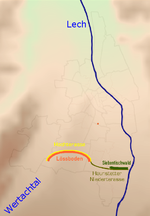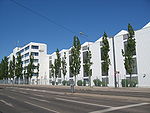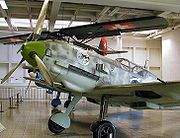
Augsburg-Haunstetten
Encyclopedia

Augsburg-Haunstetten, also known as Haunstetten-Siebenbrunn is one of the seventeen Planungsräume (English: Planning district, singular: Planungsraum) of Augsburg
Augsburg
Augsburg is a city in the south-west of Bavaria, Germany. It is a university town and home of the Regierungsbezirk Schwaben and the Bezirk Schwaben. Augsburg is an urban district and home to the institutions of the Landkreis Augsburg. It is, as of 2008, the third-largest city in Bavaria with a...
, Bavaria
Bavaria
Bavaria, formally the Free State of Bavaria is a state of Germany, located in the southeast of Germany. With an area of , it is the largest state by area, forming almost 20% of the total land area of Germany...
, Germany
Germany
Germany , officially the Federal Republic of Germany , is a federal parliamentary republic in Europe. The country consists of 16 states while the capital and largest city is Berlin. Germany covers an area of 357,021 km2 and has a largely temperate seasonal climate...
. It is the largest of the seventeen Planungsräume with an area of 32.59 km² (12.58 mi²). It is one of the most heavily populated subdivisions of Augsburg, with almost 20,000 inhabitants. The town of Siebenbrunn was its own entity until 1910 when it was annexed to Augsburg, and Haunstetten was its own city from 1952 until 1972, when Bavaria underwent extensive reform of its political subdivisions and Haunstetten was also annexed to Augsburg. The population stood at 19,973 as of January 1, 2006.
Geography

Lech River
The Lech is a river in Austria and Germany. It is a right tributary of the Danube in length with a drainage basin of .Its source is located in the Austrian state of Vorarlberg, where the river rises from lake Formarinsee in the Alps at an altitude of...
, Wertach
Wertach River
The Wertach is a river in Bavaria, southern Germany, left tributary of the Lech. Its total length is 151 km. The Wertach originates in the Northern Limestone Alps, in Bad Hindelang, east of Sonthofen . It flows north along the towns Wertach, Nesselwang, Marktoberdorf, Kaufbeuren, Schwabmünchen and...
and Singold Rivers, on a river terrace. The Planungsraum comprises five Stadtbezirke, (English: Ward, singular: Stadtbezirk) the 12th, 33rd, 34th, 35th, and 36th Stadtbezirke, which are named Siebenbrunn, Haunstetten-Nord (North), Haunstetten-Süd (South), Haunstetten-Ost (East) and Haunstetten-West, respectively. Haunstetten borders five other Planungsräume even though its entire eastern and southern borders are the municipal boundaries of Augsburg. Haunstetten borders Inningen
Augsburg-Inningen
Inningen is one of the 17 Planungsräume of Augsburg, Bavaria, Germany. It consists solely of the 41st Stadtbezirk , with which it shares a name and is coterminous. As of January 1, 2006, Inningen was reported to have a population 4,735, and an area of 13.42 km2...
to the west, Universitätsviertel
Augsburg-Universitätsviertel
Augsburg-Universitätsviertel, is one the 17 Planungsräume of Augsburg, Bavaria, Germany. It consists of one Stadtbezirk, out of the 41 that make up the city, the 32nd, with which its planning district is coterminous...
to the northwest, Spickel-Herrenbach and Hochzoll to the north. Haunstetten also shares an extremely short border with Hochfeld along its northwestern edge. Haunstetten is bordered to the east by the Haunstetten Forest, which runs along the entire eastern border of the Planungsraum. The lowland geography of Haunstetten has allowed for the development of extensive heathlands
Heath (habitat)
A heath or heathland is a dwarf-shrub habitat found on mainly low quality acidic soils, characterised by open, low growing woody vegetation, often dominated by plants of the Ericaceae. There are some clear differences between heath and moorland...
.
History
It has been known that Haunstetten is a long-settled area since the construction of a Siemens AGSiemens AG
Siemens AG is a German multinational conglomerate company headquartered in Munich, Germany. It is the largest Europe-based electronics and electrical engineering company....
factory in 1896 uncovered several sites of archaeological interest. Dating of materials from these sites have revealed the settlement of the Haunstetten area stretched back as far as the Neolithic
Neolithic
The Neolithic Age, Era, or Period, or New Stone Age, was a period in the development of human technology, beginning about 9500 BC in some parts of the Middle East, and later in other parts of the world. It is traditionally considered as the last part of the Stone Age...
period, but also date more recently to the Bronze age
Bronze Age
The Bronze Age is a period characterized by the use of copper and its alloy bronze as the chief hard materials in the manufacture of some implements and weapons. Chronologically, it stands between the Stone Age and Iron Age...
and the time of the Urnfield culture
Urnfield culture
The Urnfield culture was a late Bronze Age culture of central Europe. The name comes from the custom of cremating the dead and placing their ashes in urns which were then buried in fields...
. In Roman times
Roman Empire
The Roman Empire was the post-Republican period of the ancient Roman civilization, characterised by an autocratic form of government and large territorial holdings in Europe and around the Mediterranean....
, Haunstetten was located on a trade route
Trade route
A trade route is a logistical network identified as a series of pathways and stoppages used for the commercial transport of cargo. Allowing goods to reach distant markets, a single trade route contains long distance arteries which may further be connected to several smaller networks of commercial...
which ran from Augsburg
Augsburg
Augsburg is a city in the south-west of Bavaria, Germany. It is a university town and home of the Regierungsbezirk Schwaben and the Bezirk Schwaben. Augsburg is an urban district and home to the institutions of the Landkreis Augsburg. It is, as of 2008, the third-largest city in Bavaria with a...
, founded in 15 BC
15 BC
Year 15 BC was either a common year starting on Tuesday, Wednesday or Thursday or a leap year starting on Wednesday of the Julian calendar and a common year starting on Monday of the Proleptic Julian calendar...
as a Roman outpost, to Füssen
Füssen
Füssen is a town in Bavaria, Germany, in the district of Ostallgäu situated from the Austrian border. It is located on the banks of the Lech river. The River Lech flows into the Forggensee...
, through Bolzano, and eventually to Rome
Rome
Rome is the capital of Italy and the country's largest and most populated city and comune, with over 2.7 million residents in . The city is located in the central-western portion of the Italian Peninsula, on the Tiber River within the Lazio region of Italy.Rome's history spans two and a half...
. This was the Augustus
Augustus
Augustus ;23 September 63 BC – 19 August AD 14) is considered the first emperor of the Roman Empire, which he ruled alone from 27 BC until his death in 14 AD.The dates of his rule are contemporary dates; Augustus lived under two calendars, the Roman Republican until 45 BC, and the Julian...
road, also known as the Via Claudia Augusta
Via Claudia Augusta
The Via Claudia Augusta is an ancient Roman road, which linked the valley of the Po River with Rhaetia across the Alps. Since 2007, the Giontech Archeological Site, in Mezzocorona/Kronmetz serves as the Via Claudia Augusta International Research Center, directed by Prof...
, which itself had been laid between 47 and 46 BC. Although Haunstetten is not historically known from Roman times, finds of Roman coins imply some level of settlement.
Written History
Haunstetten was first mentioned in a historical context in 919919
Year 919 was a common year starting on Friday of the Julian calendar.- Europe :* Edward the Elder of England conquers Bedford....
, when it was known as Husteten. Augsburg became the site of the main cloister
Cloister
A cloister is a rectangular open space surrounded by covered walks or open galleries, with open arcades on the inner side, running along the walls of buildings and forming a quadrangle or garth...
for the Order of Saint Benedict
Order of Saint Benedict
The Order of Saint Benedict is a Roman Catholic religious order of independent monastic communities that observe the Rule of St. Benedict. Within the order, each individual community maintains its own autonomy, while the organization as a whole exists to represent their mutual interests...
for the Basilica for Saints Ulrich and Afra, the largest church in Augsburg, in 1012. The city retained this honor for several centuries, losing it in 1803. During the time the city held this position, it was known as the Ulrikanisches Dorf, (English: Ulrich village or Ulrich's village), and the estate house
Estate (house)
An estate comprises the houses and outbuildings and supporting farmland and woods that surround the gardens and grounds of a very large property, such as a country house or mansion. It is the modern term for a manor, but lacks the latter's now abolished jurisdictional authority...
belonging to the Abbey of St. Ulrich was located in the city. A stone from the abbey bearing the coat of arms of the abbot and the stamped date, 1715, can still be seen. The city and its churches were completely destroyed during the Thirty Years' War
Thirty Years' War
The Thirty Years' War was fought primarily in what is now Germany, and at various points involved most countries in Europe. It was one of the most destructive conflicts in European history....
, although later rebuilt.
Since 1800

Bleach
Bleach refers to a number of chemicals that remove color, whiten, or disinfect, often via oxidation. Common chemical bleaches include household chlorine bleach , lye, oxygen bleach , and bleaching powder...
factory. After 20 years the factory was bought out and developed into a larger textile mill. Other industries began to develop in the Haunstetten area, including larger companies such as Messerschmitt
Messerschmitt
Messerschmitt AG was a famous German aircraft manufacturing corporation named for its chief designer, Willy Messerschmitt, and known primarily for its World War II fighter aircraft, notably the Bf 109 and Me 262...
. A hospital and fire department were constructed in 1900 with the help of the local commerce minister, and a new school was secured for the area in 1904.
The area was severely damaged by air raids
Airstrike
An air strike is an attack on a specific objective by military aircraft during an offensive mission. Air strikes are commonly delivered from aircraft such as fighters, bombers, ground attack aircraft, attack helicopters, and others...
in the Second World War
World War II
World War II, or the Second World War , was a global conflict lasting from 1939 to 1945, involving most of the world's nations—including all of the great powers—eventually forming two opposing military alliances: the Allies and the Axis...
. May buildings were destroyed and many residents died. After the conclusion of the war, the German monetary reform
Monetary reform
Monetary reform describes any movement or theory that proposes a different system of supplying money and financing the economy from the current system.Monetary reformers may advocate any of the following, among other proposals:...
also struck the region hard, causing widespread famine and hunger emergencies, in which the Red Cross intervened. Control of the city was given back to the previous mayor by the American occupation forces
Allied Occupation Zones in Germany
The Allied powers who defeated Nazi Germany in World War II divided the country west of the Oder-Neisse line into four occupation zones for administrative purposes during 1945–49. In the closing weeks of fighting in Europe, US forces had pushed beyond the previously agreed boundaries for the...
. Haunstetten became a popular place for refugees and asylum seekers, and the area grew rapidly as new houses, apartment blocks and businesses opened. The population growth was so strong so as to necessitate the building of another school in the area, which opened in 1952, the same year Haunstetten was granted home rule
Home rule
Home rule is the power of a constituent part of a state to exercise such of the state's powers of governance within its own administrative area that have been devolved to it by the central government....
. A new Roman Catholic church was built in the city in 1954, and in 1960 a natural hot springs
Hot Springs
Hot Springs may refer to:* Hot Springs, Arkansas** Hot Springs National Park, Arkansas*Hot Springs, California**Hot Springs, Lassen County, California**Hot Springs, Modoc County, California**Hot Springs, Placer County, California...
was opened as a public attraction. The area's schools were expanded, and a new school built, between 1958 and 1968. The city was absorbed into the city of Augsburg in 1972 as part of Bavaria-wide political subdivision reform.
Involvement in World War II

Messerschmitt
Messerschmitt AG was a famous German aircraft manufacturing corporation named for its chief designer, Willy Messerschmitt, and known primarily for its World War II fighter aircraft, notably the Bf 109 and Me 262...
corporation, Haunstetten became a wartime production center during World War II. Two large production centers, Werk III and Werk IV were located in Haunstetten, in what is now Universitätsviertel
Augsburg-Universitätsviertel
Augsburg-Universitätsviertel, is one the 17 Planungsräume of Augsburg, Bavaria, Germany. It consists of one Stadtbezirk, out of the 41 that make up the city, the 32nd, with which its planning district is coterminous...
, although now these production facilities belong to EADS
EADS
The European Aeronautic Defence and Space Company N.V. is a global pan-European aerospace and defence corporation and a leading defence and military contractor worldwide...
and DaimlerChrysler Aerospace. The number of production facilities located in Haunstetten led to pressure on the local housing market as production laborers, researchers and engineers came from all over Germany to work for the Messerschmitt facilities. This led to the construction of the Messerschmittsiedlung (English: Messerschmitt settlement), which was completed in 1937 and was expanded in 1939. This influx of workers also lead to a rapid increase of the resident population of Haunstetten, which increased from 3,000 in 1933 to 8,000 in 1945. Although only 6,000 worked at the Messerschmitt facilities in 1936, this number grew to 9,000 by 1939 and by 1944 the worker population had reached 18,000 - of which 47% were either foreign or forced laborers. Three barracks were built for forced laborers to live in. Further forced labor for the Messerschmitt production facilities was obtained from a satellite of Dachau concentration camp, which was located near a gravel
Gravel
Gravel is composed of unconsolidated rock fragments that have a general particle size range and include size classes from granule- to boulder-sized fragments. Gravel can be sub-categorized into granule and cobble...
quarry
Quarry
A quarry is a type of open-pit mine from which rock or minerals are extracted. Quarries are generally used for extracting building materials, such as dimension stone, construction aggregate, riprap, sand, and gravel. They are often collocated with concrete and asphalt plants due to the requirement...
close to the border with Inningen
Augsburg-Inningen
Inningen is one of the 17 Planungsräume of Augsburg, Bavaria, Germany. It consists solely of the 41st Stadtbezirk , with which it shares a name and is coterminous. As of January 1, 2006, Inningen was reported to have a population 4,735, and an area of 13.42 km2...
.
The Messerschmitt production facilities were a very important center of arms, especially of fighter aircraft
Fighter aircraft
A fighter aircraft is a military aircraft designed primarily for air-to-air combat with other aircraft, as opposed to a bomber, which is designed primarily to attack ground targets...
such as the Messerschmitt Bf 109
Messerschmitt Bf 109
The Messerschmitt Bf 109, often called Me 109, was a German World War II fighter aircraft designed by Willy Messerschmitt and Robert Lusser during the early to mid 1930s...
. Over 34,000 of this model were produced at the Messerschmitt facilities by the end of the war. Because of the strategic importance of the aircraft works, the Messerschmitt facilities and the surrounding areas were bombed by American and British
United Kingdom
The United Kingdom of Great Britain and Northern IrelandIn the United Kingdom and Dependencies, other languages have been officially recognised as legitimate autochthonous languages under the European Charter for Regional or Minority Languages...
air raids, which killed 165 people, including 70 prisoners from the Dachau satellite camp. The American and British bombing raids caused significant damage to the Haunstetten area. Although the exact death toll of captured laborers and prisonser at the Dachau satellite camp is not known, the war and subsequent bombing raids killed 300 residents and destroyed one quarter of all residences in the area. The war was declared over in Haunstetten on April 28, 1945 as American forced claimed the area.

